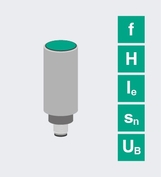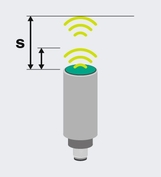Detection Method and Function

Various sensing principles can be used for different detection tasks. The sensing principle most suitable for the specific application is determined based on various considerations, such as the material of the object to be detected, the application environment, and the distance from which the object is to be detected.
Unlike inductive or capacitive sensors, magnetic field sensors react to the presence of a magnetic field. It does not matter whether this field is generated by an electromagnet or a permanent magnet. This makes magnetic field sensors especially tamper-proof and resistant to interference. Compared to the near-field sensors mentioned above, magnetic field sensors offer higher operating distances with a small housing design.
Special technical features of magnetic field sensors at a glance:
- Detection of components equipped with magnets
- Large operating distance (depending on the magnets used)
- Variable operating distance: By selecting and installing the magnet, the required operating distance can be easily adjusted
- Tamper protection and immunity: The sensor reacts exclusively to magnetic fields
- Detection through non-magnetic walls
Typical applications include:
- Door monitoring
- Component query
- Detecting components through metal walls, provided the walls are non-magnetic
The limitations of magnetic field sensors are:
- Components to be detected must be equipped with at least one magnet
- The sensing range depends on the mounting direction of the magnet
Other Principles
Depending on the application, the following sensing principles can be used as an alternative:
- Inductive sensor: for the exclusive detection of metallic objects.
- Capacitive sensor: for detecting objects made of plastic or paper, liquids (oily or aqueous), granules, and powders.
How It Works
Magnetic field sensors are noncontact. They detect objects that generate a magnetic field.
History of Noncontact Proximity Sensors
The first industrial-grade proximity sensor was developed and launched on the market in 1958 by Walter Pepperl and Wilfried Gehl. At the time, the development was driven by neighboring BASF. BASF wanted to replace the mechanical switching contacts used at the time for detecting goods with noncontact sensors that did not cause any switching sparks. The intention was to significantly reduce explosion hazards. Even the first proximity sensor was designed to be intrinsically safe in accordance with NAMUR.
Standardization
All Pepperl+Fuchs proximity sensors were, and continue to be, developed, manufactured, and marketed in accordance with the relevant standard IEC/EN 60947 "Low-voltage switchgear and controlgear—Part 5-2: Control circuit devices and switching elements—Proximity switches."
For Pepperl+Fuchs safety-related sensors, the relevant standard "Low-voltage switchgear and controlgear—Part 5-3: Control circuit devices and switching elements—Requirements for proximity devices with defined behavior under fault conditions (PDDB)" also applies.
Additional Information

Magnetic field sensors have standard key technical data that must be known to ensure proper use in plants and applications.

The sensor switches at a certain distance from the reference target. This distance is referred to as the "operating distance." The operating distance is the most important characteristic of a magnetic field sensor.









 +82 2 34819494
+82 2 34819494